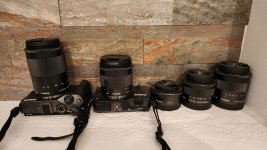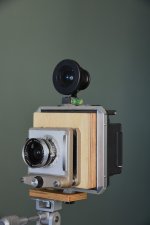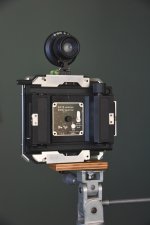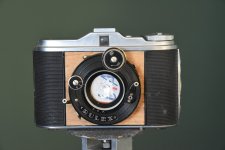I thought it would be nice to have dedicated thread to talk about cameras and such.
To start things off…
On a whim, I bought a $17 manual focus C-mount lens with M4/3 adapter for my LUMIX GX-1. It’s 35mm focal length which gives 70mm equivalent FOV in 35mm format. I wasn’t expecting much, but the lens arrived and it’s nicely built all metal (black anodized aluminum) and laser engraved markings with butter smooth operation. Multi coated lens elements, a round 12 blade aperture. When I installed it on the camera - it instantly transformed the feel and how you take pictures - because both aperture and focus are now mechanical rings and you have to use it just like the old school manual film cameras. I left the camera on aperture priority and applied compensation when needed. Test shots showed nice sharpness wide open at F/1.6 (although very narrow plane is in focus) and superb narrow depth of field to isolate the subject. Nice bokeh - smooth tonality in out of focus regions. Color rendition is excellent. I don’t see any light falloff even wide open. I did not expect it to work so well, frankly. Here are some test shots in the lab. I’m a happy camper. This is a nice portrait lens and it’s going to add another dimension to manual shooting. Damn amazing for $17!
Highly recommended! They make adapters for other camera formats. I chose M4/3 for mine. Here is the one I got. It even comes with two threaded C mount spacer rings to allow macro photography.
Lens looks like this with adapter:

Mounted on the camera it’s quite compact for a short telephoto:

Here is a closeup photo wide open, note the tight depth of field and smooth out of focus regions:

Farther away and still wide open (look at the text on the driver handles):

Color rendition is nice - very accurate:

I can’t wait to use this to take candids or on the street.
The main thing is that it brings back the muscle memory of using my old film cameras. Instead of holding to my eye, I look at the screen to focus. My camera has a magnifier patch to check focus.
To start things off…
On a whim, I bought a $17 manual focus C-mount lens with M4/3 adapter for my LUMIX GX-1. It’s 35mm focal length which gives 70mm equivalent FOV in 35mm format. I wasn’t expecting much, but the lens arrived and it’s nicely built all metal (black anodized aluminum) and laser engraved markings with butter smooth operation. Multi coated lens elements, a round 12 blade aperture. When I installed it on the camera - it instantly transformed the feel and how you take pictures - because both aperture and focus are now mechanical rings and you have to use it just like the old school manual film cameras. I left the camera on aperture priority and applied compensation when needed. Test shots showed nice sharpness wide open at F/1.6 (although very narrow plane is in focus) and superb narrow depth of field to isolate the subject. Nice bokeh - smooth tonality in out of focus regions. Color rendition is excellent. I don’t see any light falloff even wide open. I did not expect it to work so well, frankly. Here are some test shots in the lab. I’m a happy camper. This is a nice portrait lens and it’s going to add another dimension to manual shooting. Damn amazing for $17!
Highly recommended! They make adapters for other camera formats. I chose M4/3 for mine. Here is the one I got. It even comes with two threaded C mount spacer rings to allow macro photography.
Lens looks like this with adapter:
Mounted on the camera it’s quite compact for a short telephoto:
Here is a closeup photo wide open, note the tight depth of field and smooth out of focus regions:
Farther away and still wide open (look at the text on the driver handles):
Color rendition is nice - very accurate:
I can’t wait to use this to take candids or on the street.
The main thing is that it brings back the muscle memory of using my old film cameras. Instead of holding to my eye, I look at the screen to focus. My camera has a magnifier patch to check focus.
If that lens was for 35mm film, then you are only using the centre portion of the image circle, so distortion and light fall-off would definitely be minimized. Now, if you can get a tilt-shift adapter, you can use the available image circle for view camera effects. And you wouldn't need to stick your head inside a hood to check the viewing screen.
I am afraid those test shots are neither sharp nor have beautifull bokeh. Sharpness is not great but lets say OK, but that bokeh is bad and computed bokeh from modern cellphone is much better. Moreover for portraiture bokeh/bokeh transients/sharpness quality is very critical. The main problem with M4/3 is aperture, which seems very nice F/1.6, but in fact real one is F/3.2 when recalculated to FF. Because of this, real portait lenses have F/1.2 and costs almost as FF lenses.
Last edited:
The aperture is intrinsic to the lens (basically etendue or conservation of energy), and M4/3 is using subset of FF image circle. F/1.6 is F/1.6 and defines collected solid angle of light in focal length / lens diameter. Light falloff is another matter but doesn’t seem to be an issue here as I don’t see any darkening on the corners.
I’ll take some shots stopped down later but take a look at the zoomed in spot where I focused on. I can see lettering on the SMT labels. For handheld shot at F/1.6 that’s pretty good in my book.

You have some high standards for bokeh, perhaps from $1500 Leitz Summicron or Zeiss Biotar, etc,… Typically double Gauss 6 to 7 elements in 3 to 5 groups. Mostly designed by hand as computer modeling of lenses was not available then. A good analogy is how crossovers on speakers used to be designed by hand before advent of computer modeling like Xsim. Nothing wrong with either method but the latter is very controlled and less expensive to make as good or better than the former.
Also, this lens costs as much as the lens cap of a typical factory lens!
I’ll take some shots stopped down later but take a look at the zoomed in spot where I focused on. I can see lettering on the SMT labels. For handheld shot at F/1.6 that’s pretty good in my book.
You have some high standards for bokeh, perhaps from $1500 Leitz Summicron or Zeiss Biotar, etc,… Typically double Gauss 6 to 7 elements in 3 to 5 groups. Mostly designed by hand as computer modeling of lenses was not available then. A good analogy is how crossovers on speakers used to be designed by hand before advent of computer modeling like Xsim. Nothing wrong with either method but the latter is very controlled and less expensive to make as good or better than the former.
Also, this lens costs as much as the lens cap of a typical factory lens!
Last edited:
Here is my photo equipment. Mirrorless canon. Early model and later model. Magnezium body, light, small and handy. Collection of lenses to cover all the needs.
Lens on the m6 is up to 200, i do often wildlife, for instance birds in florida with it.
Wide lens on m is 11 to 22, very good for outdoors photography. Wide, but not fish eye. I like this lens. I take it with me to mt whitney or similar trips.
Next is pancake 22. Great for night photo, very sensitive. Thanks to this lens i had great photos of glowworms in waitomo cave in NZ.
Rest is your typical lenses 15-45, 18-55.
Lens on the m6 is up to 200, i do often wildlife, for instance birds in florida with it.
Wide lens on m is 11 to 22, very good for outdoors photography. Wide, but not fish eye. I like this lens. I take it with me to mt whitney or similar trips.
Next is pancake 22. Great for night photo, very sensitive. Thanks to this lens i had great photos of glowworms in waitomo cave in NZ.
Rest is your typical lenses 15-45, 18-55.
Attachments
Last edited:
Hi Adason,
Very nice system and collection of lenses. I have a 14mm F/2.5 pancake that is super compact and has my favorite 28mm equivalent view angle for wides. I used to play with Nikon D1, D100 but found they were too big and bulky. About same size as full size film gear.
Your M100 is great compact system. Having two bodies is a total pro setup. I see like like new Panasonic GX-1 bodies for not a lot of money and might get another one for a backup in case one dies. I’ll be left with paperweights for lenses.
Speaking of Mt Whitney, I used to live in California. I climbed Whitney twice. Nice trips with fond memories. Mt Williamson was a bit more epic and that whole region was ripe for telemark ski mountaineering.
Very nice system and collection of lenses. I have a 14mm F/2.5 pancake that is super compact and has my favorite 28mm equivalent view angle for wides. I used to play with Nikon D1, D100 but found they were too big and bulky. About same size as full size film gear.
Your M100 is great compact system. Having two bodies is a total pro setup. I see like like new Panasonic GX-1 bodies for not a lot of money and might get another one for a backup in case one dies. I’ll be left with paperweights for lenses.
Speaking of Mt Whitney, I used to live in California. I climbed Whitney twice. Nice trips with fond memories. Mt Williamson was a bit more epic and that whole region was ripe for telemark ski mountaineering.
The principle that Lamicz is referring to is something that people often misunderstand or simply fail to realize. At the risk of opening a big can of worms, I'll try to explain it.The aperture is intrinsic to the lens (basically etendue or conservation of energy), and M4/3 is using subset of FF image circle. F/1.6 is F/1.6 and defines collected solid angle of light in focal length / lens diameter.
It is a fact that depth of field (DOF) is determined by aperture, absolute focal length and focal distance.
It is a fact that the field of view (FOV) of a micro4/3rds camera such as yours has a crop factor of 2x which, in this case, "doubles" effective (not absolute) focal length from 35mm to 70mm).
It is a fact that a 70mm FOV camera/lens system (such as yours described above) will need to be positioned much farther from the subject than a 35mm camera/lens system (such as a 35mm lens on a full frame camera) in order to capture the same FOV.
It is a fact that this necessary increase in focal distance (to maintain FOV) will proportionally increase the DOF.
It is therefore commonly accepted that the 35mm f/1.6 lens on a 2x crop factor body, while maintaining the light-gathering ability of a f/1.6 lens, will have 2x the DOF (f/3.2).
Ok, I agree but what he should have said was the DOF is same as F/3.2 for same FOV on FF sensor. But DOF is the same for same subject distance.
Btw, there is a 50mm F/1.1 C-mount lens compatible with M4/3 for $91. An amazing price for this bright of an optic and that will give 100mm FOV with pretty shallow DOF.
Btw, there is a 50mm F/1.1 C-mount lens compatible with M4/3 for $91. An amazing price for this bright of an optic and that will give 100mm FOV with pretty shallow DOF.
Having said what I did above, I will also say that I disagree with Lamicz's comments on bokeh. Or rather, I will simply state that bokeh quality is purely subjective. Some people love ultra-smooth, "buttery" bokeh, some love the bubbly, quirky bokeh, some can appreciate all types for different types of subjects and moods.
Btw, there is a 50mm F/1.1 C-mount lens compatible with M4/3 for $91. An amazing price for this bright of an optic and that will give 100mm FOV with pretty shallow DOF.
Indeed, it is quite amazing what you can get these days for very little money. There has been a revolution in lens design/development over the past 10 years or so. After a fairly long hiatus, I returned to the world of photography and I was shocked.
BTW, this thread is dear to my heart. I currently own 8 modern (some more modern that others!) dSLR and mirrorless camera bodies, countless lenses (including adapted/converted manual focus lenses) and a decent collection of film cameras and older digital point & shoot cameras.
My favourite combination for many years was my trusty Canon EOS 5D + converted Minolta MC Rokkor 58mm f/1.2. I helped pioneer the conversion of the Rokkors to Canon EF mount - converted and sold many of them years ago.
These days I am very much in love with Fujifilm bodies. I have abandoned shooting RAW (after decades of doing so) and no longer shoot professionally. I enjoy it much more as a hobby.
This was my big hobby before audio. Here was my daily shooter in the film days. Nikon FE and 50mm F/1.2 AIS.

I would love to get one of these. I think Fuji has some of the nicest cameras. It’s a fixed lens though. Someone should make a digital back for the Fuji MF rangefinders.

I would love to get one of these. I think Fuji has some of the nicest cameras. It’s a fixed lens though. Someone should make a digital back for the Fuji MF rangefinders.
Last edited:
I think photography in the Maker age with 3D printing will be a new revolution for DIY’ers.
https://doragoodman.com/

There is so much possibilities here and it’s only starting.
I know that I can make a very good imaging spectrograph with 3D prints - the image quality and data quality is the same as a CNC’d metal one. I just checked the images from a camera with a Sony back illuminated sensor. Nice and sharp. High contrast with almost no stray light (thanks to the flocking and 3 chamber design).

https://doragoodman.com/
There is so much possibilities here and it’s only starting.
I know that I can make a very good imaging spectrograph with 3D prints - the image quality and data quality is the same as a CNC’d metal one. I just checked the images from a camera with a Sony back illuminated sensor. Nice and sharp. High contrast with almost no stray light (thanks to the flocking and 3 chamber design).
Last edited:
You are not alone in coveting the X100V, which is why (as you know) they are selling for double the retail price. There are always a few available on my local buy & sell site, and I can afford one (even at the stupid prices) but I chose to go a different route. The fixed lens was a major factor in my decision. Not that it is fixed, but that the 35mm (effective) focal length isn't ideal for me. I prefer ~28mm. I therefore chose an X-E3 body and use the 18mm f/2 on it. The combination isn't much bigger or heavier than the X100V and was a hell of a lot less money (used). Also have the option of using any of my other X-mount lenses on it, which I do.
Nice compact combo! The Olympus system is excellent if compactness is a big priority. A few years ago we bought our daughter a Canon T7i with an 18-135mm super-zoom as a graduation present. She loved it and used it a lot at home, but noticed she didn't use it as a "walk-around" much. Cell phones are pretty good for that purpose these days, after all. Fast forward to about 6 months ago - I noticed a nice OM-D EM-5 MkII on the local B&S for a ridiculously good price. Bought it and then stuck the Panasonic 14-140mm Aspherical lens on it. A compact combo (perhaps half the size of the Canon combo) that can do 28-280mm. Amazing. She still doesn't bring it everywhere, of course. 
I don't know which I have more of, amplifiers and speakers or cameras and lenses.
I was into DIY with camera equipment as well. A lot of it was restoration of old shutters and wooden view cameras, although I did manage to cobble together a few cameras out of bits and parts.
One was a 4x5 point and shoot wide angle for sheet film which also had a 6x12 panoramic adapter for 120 roll film. Another, a favourite, was a pinhole camera built from a 120 film camera with a bad lens and shutter. An extremely small hole was drilled in a piece of aluminum sheet from a beer can, Molson Canadian, and that was the lens. Another malfunctioning shutter provided the B setting. F250, baby! Depth of field out of the whazoo!
Now, I just have to develop some rolls of film that I still have around. And finish some amp projects.
I was into DIY with camera equipment as well. A lot of it was restoration of old shutters and wooden view cameras, although I did manage to cobble together a few cameras out of bits and parts.
One was a 4x5 point and shoot wide angle for sheet film which also had a 6x12 panoramic adapter for 120 roll film. Another, a favourite, was a pinhole camera built from a 120 film camera with a bad lens and shutter. An extremely small hole was drilled in a piece of aluminum sheet from a beer can, Molson Canadian, and that was the lens. Another malfunctioning shutter provided the B setting. F250, baby! Depth of field out of the whazoo!
Now, I just have to develop some rolls of film that I still have around. And finish some amp projects.
Attachments
I see 18mm Baltic Birch can be used for both speaker and cameras. 😂
Nice cameras! Your screen name makes perfect sense now.
Speaking of pinhole cameras. The best one I made was by taping a sheet of aluminum foil with a 1/4in hole on the window of a 20th floor high rise hotel window in downtown Chicago. The curtains were blacked out enough. It projected a wonderful image of the city skyline on the 3 room walls, which I used my conventional camera to take a photo of. That was a lot of fun and the image was unique. Perfect depth of field. Quite good resolution because the “film” was about 12ft by 8ft.
Nice cameras! Your screen name makes perfect sense now.
Speaking of pinhole cameras. The best one I made was by taping a sheet of aluminum foil with a 1/4in hole on the window of a 20th floor high rise hotel window in downtown Chicago. The curtains were blacked out enough. It projected a wonderful image of the city skyline on the 3 room walls, which I used my conventional camera to take a photo of. That was a lot of fun and the image was unique. Perfect depth of field. Quite good resolution because the “film” was about 12ft by 8ft.
Checking out the 35mm f/1.6 lens outdoors. Focused on the acorn a squirrel left on the top edge of the bench. Interesting out of focus bokeh effects. The color rendition on the lens is nice.

Here’s a closeup indoors.

I am looking at this 50mm F/1.1 lens for M4/3 format. Not a bad price.

Here’s a closeup indoors.
I am looking at this 50mm F/1.1 lens for M4/3 format. Not a bad price.



